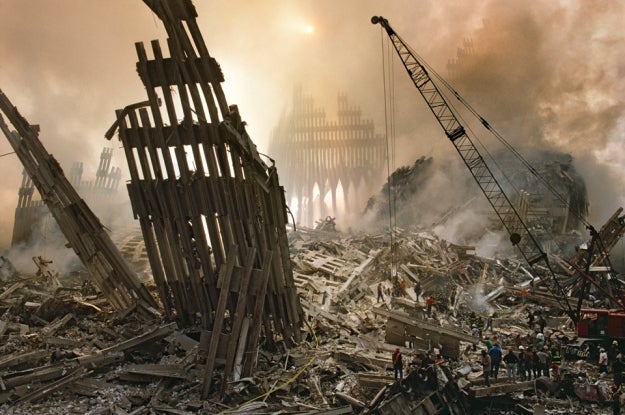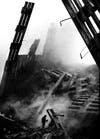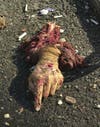9.11.01: The Photographers’ Stories, Pt. 4—”Whatever It Takes”
As the sun sets over the horrific scene at Ground Zero, the photographers continue to document (and join) the recovery...

As the sun sets over the horrific scene at Ground Zero, the photographers continue to document (and join) the recovery effort. Access to the chaotic scene is often hard-won.
Todd Maisel: After I left David I ran into Monika Graff—another photographer—in Battery Park. I’m a tough guy, but that’s when I broke down and started to cry. I had to let it out. But once I got it out of me I realized that I had a very important mission that day, and for whatever time I had left on this earth. It’s funny how photography can have that kind of mission. I don’t know why, but it does.
Yoni Brook: I was down there walking around the site until maybe 5 p.m. I didn’t have a way of calling my editors in Washington. Right at the beginning I got all this dust and stuff in my eye and couldn’t see for a minute. I remember thinking, “Oh my God, I’m really here all alone. Nobody knows I’m here, there’s no one around here.” All of a sudden it occurred to me how vulnerable I was. More and more people showed up as the day went on, but if you were there in the middle of it and looked like you were supposed to be there, people didn’t question you.

Spencer Platt: The first day it was chaos, and you could get past the barriers. But by the second or third day, they locked it down pretty well. And then they brought in the National Guard. But if you’re a serious photojournalist, you needed to get down there. You needed to document this. There were cases of photographers dressing up like firemen. If that’s the kind of unfortunate steps you have to take, then so be it.
John Botte: (As an NYPD detective, Botte was a 9/11 first responder.) I took my first shot about 5:30 p.m. on September 11 on my first trip out onto the pile. We had lost a lot of people. A lot of my friends perished, people I was just talking to an hour before. My eyes were burned and a couple of our guys were injured. But we wrapped our heads around it and got a strategy together, and everybody started going out into the pile. When we got out there the first time, the only words [Police Commissioner Bernard] Kerik he said to me were, “Do your thing with that camera.” And whenever I was able to, in between my duties, I would look for that sliver, that sixtieth of a second, when I could compose a shot that would have an impact. I was with the commissioner and the mayor and the whole detail, so I had to be very, very discreet with the camera. You can’t point it in someone’s face. You see the composition, you previsualize it, bring the camera up, look through the range finder, compose it, click, put the camera back down, end of story. There was no “Hold that right there.”
In my three-and-a-half months on the pile I photographed 56 rolls, all on Leica and all on black-and-white film. Most of that was photographed in the first 48 hours of the attack, while that smoke was thick and heavy and that smell and that 2,000-degree vapor was pouring from the pile, and the beams were so hot you couldn’t stand still because they’d start to melt the rubber on your boots.

Allen Tennenbaum: I wish I had gotten closer…to the middle of the pile. I look at my pictures [from West Street] and I see what’s in them, and I wish I had just gotten closer. But I really felt that I should leave and get the pictures out, to meet deadlines. So that’s what I did. I went home.
Steve McCurry: We shot down at Ground Zero until nine at night. Then I walked home, but I couldn’t sleep. At 3:30 in the morning I got up and walked back down there. As you can imagine, there was serious security, police, firemen, soldiers. But it was very clear to me this needed to be documented; I knew I had to do whatever I had to do to. I found a way to sneak in by cutting through a fence, which allowed me to spend the morning of September 12 onsite. I eventually got removed by the police. They were really angry—the police, the firemen, everyone down there—emotions were running very high. One fireman threatened to beat my brains in with a shovel. I understood their position completely. From their point of view we were there as tourists or spectators, when really we were there to record history, to create a record of this evil deed. The record of photography and magazines and radio and television is how we’re informed and how we know what’s going on in the world. This was something that absolutely had to be documented.
And that was basically the end of my coverage. Other photographers kept going back, but I didn’t. After I did my initial edit of my photos for the Times I didn’t really look at them for several years, until I started doing a major edit through my entire archive. At that point it became more of a historical document.
Yoni Brook: Around 11 p.m. or midnight after 9/11, they weren’t really letting people back in. I went back through Chinatown, looking for cops and then sneaking around them. I spent the night in 2 World Financial Center, overlooking the pile. In the morning I shot sunrise coming up over it, and that really stayed with me. It was so incredibly beautiful. All this steam and smoke, and then the sunlight coming through it. I was alone in this little room and about 9 or 10 a.m. this photographer came with a strange flash bracket and an assistant. I was like, “Who is this guy?” It was Steve McCurry. He was super nice.

After I finished that morning I left my little hiding nook and went back to the Winter Garden [an atrium in the World Financial Center]. It was empty inside, and there were all these garbage bags. I snapped a few photos of people transporting these bags. I didn’t even know what was in them. Turns out it was a makeshift morgue. I didn’t even know what I’d stepped into. After I’d taken about 10 frames, this cop confronted me. “Give me all your film,” she says. I was like, “Uhhh, First Amendment.” I hadn’t slept; I was totally out of my mind. In my hip pocket I had 15 rolls of film that I had shot that night and that morning. So I immediately gave her the film from the camera.
Todd Maisel: One of the most controversial photos I took that day was a picture of a severed hand on the ground. It ended up in a Swiss museum and in a book called Controversies. The Daily News ran it, and there were some people who thought it was a terrible thing to do. You know what? Too bad. This is what it was. It was a horror. The picture was the Daily News saying, “The horror of this day must not be reduced. You can’t hide the terrible things that occurred.” I saw body parts all over the place.
Mario Tama: I met our colleague Chris Hondros the night of 9/11. He called me the morning of September 12 and said we could really use an aerial-type picture. So I kept trying to go into these different buildings. I finally got into one building and climbed up eight or ten flights. I remember looking down and to me it just summed up what the whole thing was all about: Even in the immensity of this evil and horror and destruction, you’ve got hope, you’ve got solidarity, you’ve got people coming together.
There’s this stereotype of New York as a hard, cold, intense place of selfish people. But this was beautiful and incredible. Every hour or two some siren would go off, which would mean that a building was going to collapse, and all the workers would run off to the side. Then the siren would stop and they’d come back and they’d just be sifting through.

Spencer Platt: A couple of days later all the journalists were desperate to get down to Ground Zero. It took us the better part of six hours of slowly sneaking, block by block, to get down there. We got into a car park right near Ground Zero and hid under cars for around two hours until it was dark. Then we got out and snuck in.
It was surreal. Totally silent and black, with fires burning. It was something out of Dante. All the firemen were working in one main pit of Ground Zero. They had taken a break and we were walking around. There were probably just four or five firemen just kind of looking at the ground. We had about 45 minutes until someone kicked us out. But we were happy. We got our pictures.
Yoni Brook: I don’t think I slept the first couple days. The night after my all-nighter at Ground Zero, Washington Post photographers—my idols—started arriving. They wanted to get down there, but they’re all from D.C. I had done it twice already, so I kind of knew where the checkpoints were and how to get around them.
I learned a lot from Michael Williamson when I took him down there. He was like, “First we get the long lens shots; that way if we get kicked out at least we covered our bases.” We went into this parking garage, with all these empty cars covered in dust with blinking alarm lights. There were no lights anywhere else. It was very eerie. And I remember he decided to get to this window. We had to break down a door to get to it. So he starts kicking in this door, and this piece of plaster falls. And I’m thinking, “I can’t carry Michael Williamson out of here.” He got the shot

Steve McCurry: I had just spent a very calm, contemplative, serene month in these Buddhist monestaries in Tibet, where it was very empty and quiet, so to wake up in the morning and have all of our lives change was overwhelming, very hard to deal with. The smell of the burning towers wafted up into my neighborhood for what seemed like weeks. In my neighborhood, the World Trade Center was part of the landscape. In Washington Square Park you could see the towers through the arch. For years I couldn’t bear to look down to lower Manhattan and not see that landmark.
Suzanne Plunkett: This wasn’t one of those traumatic assignments that you cover and then go home to your separate life with your friends and family. Everyone around me was very upset by the events, so there was no emotional barrier between work and home. I wanted to get away, yet I wanted to stay to cover the biggest news story hadevercovered. Every assignment for the next year had some sort of September 11 connection—you couldn’t escape it.
Yoni Brook: The other weird thing from that day that I really remember, more than any image, is the smell. I think smell connects to a deeper emotional pathway to your brain than even your eyes do. And it was like this volcanic smell—it must have been like what Pompeii smelled like or something. At my parents’ house I still have what I wore that day, sealed up in a garbage bag. I’ve never opened it. I don’t know when I’ll open it. That smell encapsulated the day to me. It was just revolting, and a smell that I had never smelled before.

Mario Tama: I went to Afghanistan two months later. Then to Iraq. Then I did Hurricane Charley and Hurricane Katrina, and then the Haiti earthquake. Katrina was the first time I remember since 9/11 where I was able to focus on another domestic story that felt as important.
Usually, our domestic stories are just politics or don’t have the same kind of gravitas and pathos. But after you shoot something where 3,000 people die in front of you, you don’t match that intensity very easily. We’re lucky to live in such a safe country where these kinds of things are so rare.
I feel like I became a New Yorker on 9/11 for sure. I was already in love with the city, but in a superficial way. It just formed a deep connection with the heart of who New Yorkers really are when you get beyond the veneer.
John Botte: People ask me if I feel bad or sad because I knew a lot of those firemen and cops. And I knew a lot of these guys for years. People say, “You must be heartbroken.” And I say I don’t feel sorrow for one single person. What I feel is pride. I am proud of every one of them. Because they gave themselves, and that’s what you raise your right hand for. I served, and I served proudly. And I would do it again. I wouldn’t hesitate one bit.
I chose to serve the people. And I wouldn’t trade being a New York City cop for the world. I’m not even a registered voter. I have never cast a vote in my life. I’m not a Democrat, I’m not a Republican. I am a servant of the people. I don’t care who you are, I don’t care what you believe in, I don’t care what your religion is, I don’t care what color your skin is. I was there to serve, and I served.
I was supposed to be dead by now. I contracted lung disease from being out on the pile, and I still have a lot of setbacks. But I’m very tenacious; I don’t give up. They gave me till Christmas of 2003, and I’m still here in 2011. So I’ll just keep moving forward, and if I go tomorrow, I’ll go with a camera in my hand and my shield in my back pocket. I had fun. If I’m on this earth another 15 years, then so be it. I’ll try to see and do as much as I can.
David Handschuh: For a long time, [in my teens and twenties], when I was chasing news, it was easier to disconnect from a human that was injured or dying or dead. In the post–9/11 world, I’m more acutely aware that we’re not just taking photographs, we’re intersecting with people, often at a horrible point in their lives. So how we act, how we behave, what our ethics are, how we deal with taking a photograph of somebody who’s very hurt or dying or dead —I’ve become more aware of those issues.
Todd Maisel: I went to war because of this. I had never gone to war before. I was always a street photographer. Fires, homicides—that was my thing. I would cover the inner city and the terrible things that went on. After 9/11 I was an embed in Iraq with the First Marine Expeditionary Force. The people I lost on 9/11 give me strength. I have their pictures on my dashboard. They ride into battle with me every day.
Allen Tannenbaum: I’ve been covering the progress of the construction at the World Trade Center site, as often as I can. Every chance I get to go down there I …do pictures of the construction there, which is pretty amazing at this point. It’s getting really quite big right now, so it’s fantastic. It’s finally visible from our place in Tribeca.
Todd Maisel: I think that we as photojournalists have a mission to keep history alive. The thing about history is, if you don’t remember it you repeat it. And God knows I would never in my whole life want to have to go through 9/11 again—great photos or whatever the hell, I don’t want to be there. I don’t want it to happen again. But I guess if it would happen—I’d have to be there. That’s just my mission.
9/11/01: The Photographers’ Stories—Part 1
9/11/01: The Photographers’ Stories—Part 2
9/11/01: The Photographers’ Stories—Part 3
This is the final part of American Photo’s expanded four-part oral history of September 11, 2001, by the photographers who documented it. Click here for part one, part two, and part three. A condensed version appeared in the September/October 2011 issue of American Photo magazine.
This story is also available as a free download for the iPad, with even more photos, photographer interviews and portfolios.
We hope you will take this opportunity to donate to one of several charities benefiting those affected by the September 11 attacks.